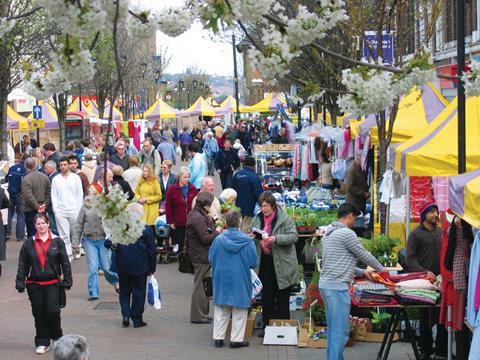Local loyalty schemes can bring footfall and revenue to beleaguered high streets, but are they worth the cost and how can they realise their full potential? Rebecca Thomson finds out.

Loyalty cards have brought big-name retailers a long way – from Boots to Tesco, the insight these schemes generate is now a crucial part of a successful retail business.
If this power could be harnessed for the benefit of struggling smaller town centres, the theory goes, it could help turn around high streets. And it does make sense to develop insight on a local level. If smaller high streets and town centres are able to boost loyalty, produce insight into local habits and ultimately increase footfall, loyalty schemes could be the answer that many blighted high streets are looking for.
Buying into it
But it’s not as simple as it sounds.
Loyalty schemes have high upfront costs and are fairly expensive to run. They need lots of users if they are to generate the kind of insight helpful to retailers, and overall can be difficult schemes to manage – especially across disparate retailers and other organisations. While there are growing numbers of local schemes designed to help enhance high street trade, larger retailers are yet to completely embrace the idea of local loyalty schemes.
As Game chief marketing officer Dave Hughes says: “We do some local initiatives, and we have come across one or two that are interesting. But you need scale to get these things working properly. The analysis we would want is not cheap.”
Many local projects operate more as discount schemes than the loyalty cards shoppers have become accustomed to at national chains. Data collection and analysis are expensive and difficult, and a fully fledged loyalty offering is an aspiration for many local schemes, rather than something they are already achieving.
“A lot of schemes are not collecting data yet,” says Martin Blackwell, chief executive of the Town Centre Management Association. “Many are in fairly early stages.”
But that’s not to say there aren’t plenty of plans to develop these schemes into a more complete loyalty offering – and technology is helping new projects to surface.
In Reading, software company MoLo is trialling near field communication technology on smartphones, starting this month. The company hopes up to 100,000 customers will use their phones to spend coupons, which they will have been sent by a retailer or downloaded from MoLo’s site. The aim is to accumulate a pile of useful data on how people shop using coupons, and retailers can award their own loyalty points on the phone if they want to.
MoLo will provide customers with a near field communication chip, which is attached to their phone and allows them to collect loyalty points by holding their phone next to a scanner – which the retailer must buy if they want to participate in the scheme.
“We will very quickly accumulate a huge amount of data on shopping habits,” says MoLo vice-president Chris Davies. The scheme will also allow customers to load bus passes on to their phone, so retailers will be able to send relevant offers to customers as they are on the bus on the way into the town centre.
While the scheme won’t act as a complete loyalty initiative for the Reading area, Davies says the platform will make it much easier for smaller retailers to set up their own loyalty schemes without the upfront expense of a card. “Smaller retailers have found it very difficult to compete with bigger entities. This is a way of using technology to even that up,” he explains
Improving trade

Wiganplus is another scheme with big ambitions. Retail consultancy CACI identified Wigan as one of the most vulnerable town centres during the recession, and loyalty company HometownPlus launched the Wiganplus card to try and boost trade.
It launched in July this year, and HometownPlus chief executive Tony Meehan says the scheme has “absolutely” improved trade, and that the card helps retailers shift unwanted stock by allowing them to provide specific offers. It has several thousand shoppers signed up at the moment and the plan is for quick growth, with Meehan hoping for 150,000 members to be signed up by March.
Wiganplus will act as a library card as well as a loyalty card, and running a scheme with multiple uses is a popular ploy for local schemes to attract more users. But again, getting big retailers on board can be challenge, although the data generated by schemes could potentially be useful to chains.
Meehan says the issues partly stem from it being difficult to speak to the right people in big organisations.
“A local manager may not have it within his remit to make a decision on a scheme like ours.
“But we have got some learning to do in how we approach them. We have difficulty in reaching the right people and getting them to make decisions when decision making is so centralised.”
But he insists that local schemes are the best way forward for struggling high streets. Not only do they help independent retailers, everyone benefits from increased footfall and the schemes tie nicely into the localism trend that so many retailers are trying to tap into.
“Localism is becoming far more important, and we are going to see a lot more of these kinds of schemes,” he says.
Simon Spode, marketing officer at Rotherham Investment and Development Office, agrees it is the local angle that loyalty cards should emphasise. Rotherham’s Shop Local scheme has 11,000 members and has recently signed up jewellery chain H Samuel, which offered 10% off for customers spending £50.
But it’s the town centre’s independent offer that the initiative really wants to assist through the card. Spode says: “The scheme helps promote particularly the offer of our independent retailers and the town centre’s offer as an independent alternative.” The aim, he says, is to emphasise that Rotherham offers something slightly different to the norm, giving people a reason to shop there and making sure independents have their voice heard. But the indirect benefits for big retailers are still there – higher footfall is better for everyone.
While local loyalty schemes have a distance to go before they reach their full potential, they could be an exciting part of the future for many town centres. It may require work, but the best could work wonders for the high street.
Local loyalty schemes
- Rotherham’s Shop Local scheme Rotherham’s scheme has over 100 town centre shops involved that provide discounts and offers to 11,000 cardholders. The overall aim is to promote the unusual, alternative offer of Rotherham high street
- Wiganplus Launched in July after a trial of seven months, organisers are targetting 150,000 users by March. They want the card to act as a library card as well, and will work with local transport providers and local authorities to give customers plenty of reason to sign up
- MoLo Rewards The software company is running a smartphone loyalty trial involving 30 retailers and, it hopes, up to 100,000 people. Shoppers need to download an app and attach a near field communication chip, which MoLo provides. They will then be able to use their phones to redeem coupons and collect loyalty points. MoLo is not running its own loyalty scheme, although its technology allows retailers to set their own schemes up more easily and cheaply than if they had to pay for cards, and it says it will collect data from people using their phones to redeem coupons. Retailers on the scheme will also be able to send targeted coupons to customers


























1 Reader's comment